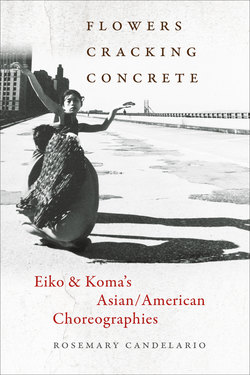Flowers Cracking Concrete

Реклама. ООО «ЛитРес», ИНН: 7719571260.
Оглавление
Rosemary Candelario. Flowers Cracking Concrete
Отрывок из книги
FLOWERS CRACKING CONCRETE
Eiko & Koma’s Asian/American Choreographies
.....
The early 1970s was a period of major departures for Eiko and Koma, who were at that point on their way to becoming Eiko & Koma. They left school, two major figures of avant-garde dance, and finally even their country. Suzanne Carbonneau emphasizes that Eiko & Koma were not traveling in order to perform. “Performing was, rather, a strategy for discovering the world … while they ‘researched [their] lives.’”50 Although she seems to mean this quite literally—dance was a means for the pair to see the world and travel beyond Japan—her phrasing quite nicely points to the way that Eiko & Koma have since used their dance to understand their relationship to time, history, humans, and nonhumans. In a manner prescient of their future movement style, in which a specific beginning or end is less important than noticing and participating in the ever-evolving moment, the pair embarked on a slow journey whose destination was not entirely clear at the outset, departing Japan on a boat bound for the Soviet Union. The one thing they knew for certain was that they had made a conscious decision not to go to the United States. On the one hand, their opposition to the Vietnam War precluded the United States as a destination; going there, they felt would signal an implicit acceptance of the government’s actions. On the other hand, they had a sense that everyone was going to the United States at that point, and indeed a number of Japanese avant-garde artists, including Yoko Ono and Yayoi Kusama, had been welcomed into the New York art scene in the 1960s. Spain was one possible destination—Eiko remembers studying Spanish on the ship—however, they ultimately rejected that option because of their political opposition to Francisco Franco’s fascist dictatorship. After their ship docked, the pair then took a train to Moscow. Somewhere along the way they decided to go to Germany, and in Moscow they boarded a plane to Vienna, where finally they took a short train ride to Munich.
Ending up in Germany was not random, however. In a discussion about this period of their lives, Koma pointed to the long history of artistic exchange between Japan and Germany, and in particular to the links between their teacher, Ohno, and Mary Wigman’s modern dance style.51 Cultural exchanges among Japan and European countries had in fact been commonplace since the Meiji Restoration in 1868, when the Japanese began a concerted effort to show their country, policies, and products to be on a par with those of the Western powers, often through the adoption or adaptation of Western practices and conventions. At the same time, all things Japanese enjoyed an enormous popularity in the United States and Europe, prompting artists there to themselves adopt or adapt Japanese techniques. For example, the aesthetics of noh circulated to Europe and were incorporated into the practices of playwrights and theater directors such as W. B. Yeats, Jerzy Grotowski, and Samuel Beckett; in turn, Japanese theater practitioners of the 1960s and 1970s were themselves influenced by some of these same European artists.52 It was not unusual then that the Japanese pioneers of modern dance studied in Europe in the 1920s, some with Mary Wigman herself, and introduced German “new” dance to Japan. Koma remembers Ohno talking to them about Kreutzberg and Wigman. Koma and Eiko themselves discovered pictures of Dore Hoyer in the Music Library at the Tokyo Bunka Kaikan 東京文化会館. Of these German dancers Eiko says, “They were like kind of romantic figures for our soul. We couldn’t romanticize our own teacher because we were too rebel [sic] ourselves. We were always questioning; and there was some senior students who look at Hijikata and Ohno like this [looking at them as if they were god]…. I just couldn’t get involved in that because we were always questioning. But those photos became instead my kind of romantic … where my romantic idea can go forth.”53
.....